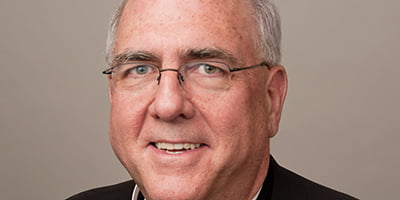by Archbishop Joseph F. Naumann
February 22 is the feast of the Chair of St. Peter. This ancient feast might seem odd to us. Why do we have a feast for a chair?
In the ancient world, the great teachers usually gave their students instruction while seated on a chair. The chair became the symbol of their authority as a learned and competent scholar and teacher.
The word “cathedral” finds its origin in the Greek word for “chair.” A cathedral is the church where the bishop’s chair is located — a symbol of his teaching and preaching authority.
In St. Peter’s Basilica in Rome, there is a magnificent depiction of the Chair of St. Peter adorning the wall behind the main altar. It is a reminder of the primacy that was given to Peter by Jesus himself and the great gift the successor of St. Peter is to the church.
In the 16th chapter of St. Matthew’s Gospel, Jesus asked his disciples: “Who do people say the Son of Man is?” Then, he asked them the much more important question: “But who do you say that I am?” Peter replied: “You are the Messiah, the Son of the living God!”
Jesus responded to Peter’s confession of faith: “Blest are you, Simon son of Jonah! For flesh and blood has not revealed this to you, but my heavenly Father. And so I say to you, you are Peter, and upon this rock I will build my church, and the gates of the netherworld shall not prevail against it. I will give you the keys to the kingdom of heaven. Whatever you bind on earth shall be bound in heaven; and whatever you loose on earth shall be loosed in heaven.”
Jesus actually gave Simon the nickname Peter, which means rock. The conferral of keys in the ancient world was a conferral of authority and power. In our culture, fathers show great confidence in their sons when they entrust them with the keys to the family car. Jesus entrusted to Peter the keys of the kingdom, the keys of the church.
This feast of the Chair of St. Peter holds a special importance at this moment in the life of the church. Next Thursday (Feb. 28), Pope Benedict XVI’s resignation of the Petrine office will take effect. The conclave of cardinals to elect a new pope will convene in the middle of March.
Incidentally, the word “conclave” comes from the word for “key.” In the Middle Ages, sometimes it took as long as three years for the College of Cardinals to elect a new pope. If the cardinals could not reach agreement, they would disband for months or even more than a year, before they would reassemble to choose the next pope.
As a result, the custom developed of locking the doors of the assembly of cardinals, not permitting them to leave until they had fulfilled their duty of electing the next pope. In recent history, the College of Cardinals has been able to come to a two-thirds consensus on its selection of a new pope within a week.
This is an incredibly significant moment in the life of the church. The selection of the successor of Peter is an extremely important decision that will have a tremendous impact for years on the life of the church and the world.
Again, I ask every member of the Archdiocese in your personal prayer to pray that God will bless Pope Benedict in his final days of serving the church as the successor of St. Peter. Pray that the Lord will bless the one whom we have called Holy Father for almost eight years, as he relinquishes the responsibilities he has shouldered so ably for the church and begins a new chapter of his life — one of prayer and reflection.
Pray also for the College of Cardinals that it will be docile to the guidance of the Holy Spirit in the selection of the next pope. Let us implore Our Lord to raise up the individual who is best prepared to shepherd the universal church.
When he returned from the conclave that elected Benedict XVI, Cardinal Francis George of Chicago was asked by reporters what he was thinking as he stood behind the new pope on the balcony overlooking St. Peter’s Square.
Cardinal George said that his eye focused on the obelisk in the center of St. Peter’s Square. This same obelisk was located in the middle of the Roman Circus, where St. Peter and many other early Christians were martyred by Roman soldiers who had been ordered to do so by the Emperor Nero. The obelisk may have been the last physical object Peter gazed upon in this world.
Cardinal George said that he began to think: Where is Nero? Where is Caesar Augustus? Where is Attila? Where is Napoleon? Where is Hitler? Where is Stalin? Where are any of these extremely powerful men of their time and their successors today? What impact do they have on the world today?
Cardinal George then thought: But, I know where Peter is. I know where his successor is. The successor of Peter has continued now for 2,000 years to affect profoundly millions and millions of Christians.
What a grace to have the office of Peter still guiding and leading the church today. Let us pray fervently for God to bless the church with another extraordinary successor of the Apostle St. Peter. Let us pray for a pope who will be well prepared to lead the church in the task of the new evangelization!


